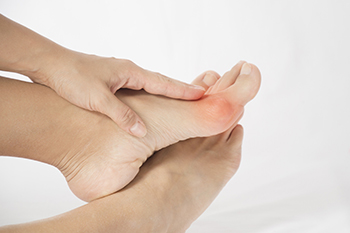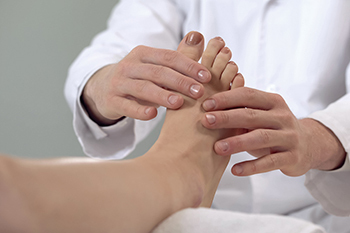
Wilmington (937) 382-2347
Fax
(513) 932-1606

Wilmington (937) 382-2347
Fax
(513) 932-1606

People who frequently wear high heels may not realize the dangers that coincide, beginning with an increase in tripping hazards. Additionally, high heels may significantly contribute to incurring a foot or ankle injury, and circulation may be negatively affected, too. Some of the foot conditions that can gradually develop from wearing high heels include Achilles tendonitis, bunions, hammertoes, blisters, corns, and calluses. The body’s weight can be affected by leaning forward as a result of the shape of the shoe and this can cause the weight to shift to the balls of the feet. Some measures can be implemented that can provide comfort while wearing high heels. These can include choosing a lower heel, wearing them less often during the week, and stretching the feet and ankles as often as possible. Podiatrists can answer any questions you may have regarding how high heels can affect the feet, and it is suggested that you consult with this type of doctor if you would like more information.
High heels have a history of causing foot and ankle problems. If you have any concerns about your feet or ankles, contact Dr. Gerald Perelman from Ohio. Our doctor can provide the care you need to keep you pain-free and on your feet.
Effects of High Heels on the Feet
High heels are popular shoes among women because of their many styles and societal appeal. Despite this, high heels can still cause many health problems if worn too frequently.
Which Parts of My Body Will Be Affected by High Heels?
What Kinds of Foot Problems Can Develop from Wearing High Heels?
How Can I Still Wear High Heels and Maintain Foot Health?
If you want to wear high heeled shoes, make sure that you are not wearing them every day, as this will help prevent long term physical problems. Try wearing thicker heels as opposed to stilettos to distribute weight more evenly across the feet. Always make sure you are wearing the proper shoes for the right occasion, such as sneakers for exercising. If you walk to work, try carrying your heels with you and changing into them once you arrive at work. Adding inserts to your heels can help cushion your feet and absorb shock. Full foot inserts or metatarsal pads are available.
If you have any questions please feel free to contact our office located in Wilmington, OH . We offer the newest diagnostic and treatment technologies for all your foot and ankle needs.

There are some people who refer to bunions as a bone disorder. This foot condition is the result of a foot structure abnormality, and can be caused by genetic factors. Additionally, patients who choose to wear shoes that do not have adequate room for the toes to move freely in may notice a bunion is developing. It is defined as a bony protrusion on the side of the big toe, and in severe cases, may be large enough to shift the other toes toward each other. There may be existing medical conditions that may lead to getting a bunion. These can include having a low arch, rheumatoid arthritis, or possibly from having endured a foot injury. Common symptoms that affect many people with bunions can consist of redness, numbness, and there may be a burning sensation in the affected joint. Mild relief may come from wearing shoes that are larger which can accommodate the protrusion, and it may help to place a protective covering over the bunion. If you have a bunion, it is advised that you are under the care of a podiatrist who can offer you effective treatment options.
If you are suffering from bunions, contact Dr. Gerald Perelman of Ohio. Our doctor can provide the care you need to keep you pain-free and on your feet.
What Is a Bunion?
A bunion is formed of swollen tissue or an enlargement of boney growth, usually located at the base joint of the toe that connects to the foot. The swelling occurs due to the bones in the big toe shifting inward, which impacts the other toes of the foot. This causes the area around the base of the big toe to become inflamed and painful.
Why Do Bunions Form?
Genetics – Susceptibility to bunions are often hereditary
Stress on the feet – Poorly fitted and uncomfortable footwear that places stress on feet, such as heels, can worsen existing bunions
How Are Bunions Diagnosed?
Doctors often perform two tests – blood tests and x-rays – when trying to diagnose bunions, especially in the early stages of development. Blood tests help determine if the foot pain is being caused by something else, such as arthritis, while x-rays provide a clear picture of your bone structure to your doctor.
How Are Bunions Treated?
If you have any questions, please feel free to contact our office located in Wilmington, OH . We offer the newest diagnostic and treatment technologies for all your foot care needs.

Many children develop a blister on their feet at least once during their youth. Blisters are a common condition that can develop on the feet. Blisters can form on the back of the heel for many people while wearing a new, ill-fitting pair of shoes because the shoes can persistently rub up against the heel. These blisters are essentially bubbles that form on the skin, and they can be filled with blood or pus. Besides friction, blisters can be caused by sunburns, insect bites, and burns, among other things. Although many cases of blisters do not require medical attention, you might consider seeing a medical professional under certain circumstances for your child. For example, if the skin around the blister has noticeable discoloration, it may be wise to consult with a podiatrist. It could be particularly problematic when the color of the skin changes to red, gray, or purple. In the same vein, when the skin surrounding a blister becomes tender to the touch, it might be time to schedule an appointment with a podiatrist. Lastly, if your child complains to you that their blisters have started producing a foul odor, this can also be a sign to seek medical guidance. Don’t take chances with your children’s blisters.
Blisters are prone to making everyday activities extremely uncomfortable. If your feet are hurting, contact Dr. Gerald Perelman of Ohio. Our doctor can provide the care you need to keep you pain-free and on your feet.
Foot Blisters
Foot blisters develop as a result of constantly wearing tight or ill-fitting footwear. This happens due to the constant rubbing from the shoe, which can often lead to pain.
What Are Foot Blisters?
A foot blister is a small fluid-filled pocket that forms on the upper-most layer of the skin. Blisters are filled with clear fluid and can lead to blood drainage or pus if the area becomes infected.
How Do Blisters Form?
Blisters on the feet are often the result of constant friction of skin and material, usually by shoe rubbing. Walking in sandals, boots, or shoes that don’t fit properly for long periods of time can result in a blister. Having consistent foot moisture and humidity can easily lead to blister formation.
Prevention & Treatment
It is important to properly care for the affected area in order to prevent infection and ease the pain. Do not lance the blister and use a Band-Aid to provide pain relief. Also, be sure to keep your feet dry and wear proper fitting shoes. If you see blood or pus in a blister, seek assistance from a podiatrist.
If you have any questions, please feel free to contact our office located in Wilmington, OH . We offer the newest diagnostic and treatment technologies for all your foot care needs.

The ankle is a necessary and critical part of the human body. The ankle joint allows the foot to move in different directions and makes walking and running possible. However, the ankle can be very susceptible to suffering from certain kinds of injuries. For example, broken ankles can be a serious threat to your health. Importantly, broken ankles are distinctly different from sprained ankles. When an individual breaks their ankle, the bones become essentially fractured. This is to say that bones such as the tibia, fibula, or talus can become fractured. If you have a broken ankle, you might experience several different symptoms. Commonly, an individual might experience feelings of pain or even swelling. Contrastingly, a person who sprains their ankle injures the ligaments surrounding the ankle, not the bones. When a person sprains their ankle the tissues become strained or overly stretched. Although these two injuries are different, it is possible to experience both at the same time in a very severe ankle injury. If you are worried about the health of your ankles, contact a podiatrist for more information about broken and sprained ankles.
Broken ankles need immediate treatment. If you are seeking treatment, contact Dr. Gerald Perelman from Ohio. Our doctor can provide the care you need to keep you pain-free and on your feet.
Broken Ankles
A broken ankle is experienced when a person fractures their tibia or fibula in the lower leg and ankle area. Both of these bones are attached at the bottom of the leg and combine to form what we know to be our ankle.
When a physician is referring to a break of the ankle, he or she is usually referring to a break in the area where the tibia and fibula are joined to create our ankle joint. Ankles are more prone to fractures because the ankle is an area that suffers a lot of pressure and stress. There are some obvious signs when a person experiences a fractured ankle, and the following symptoms may be present.
Symptoms of a Fractured Ankle
If you suspect an ankle fracture, it is recommended to seek treatment as soon as possible. The sooner you have your podiatrist diagnose the fracture, the quicker you’ll be on the way towards recovery.
If you have any questions, please feel free to contact our office located in Wilmington, OH . We offer the newest diagnostic and treatment technologies for all your foot care needs.